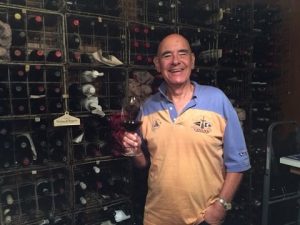
In part one of this special series we looked at the early history of Coonawarra. In this post we briefly look at the early history of Wynn’s Coonawarra Estate.
PART TWO
When 21-year-old Shlomo Weintraub fled Russian-occupied Poland for Australia, just before World War 1, it is doubtful anyone could have guessed how important he would be to the Australian wine industry. If the name Redman is a nice coincidence for a winemaker, Shlomo was even more blessed: Weintraub is the German word for wine grape. Shortly after arriving, however, Shlomo changed his name to Samuel Wynn, apparently not realizing that wynn was an Old English word for wine.
Fast-forward many years, and we find Samuel running a wine bar in Melbourne, where he regularly served Coonawarra red – purchased via Woodley’s, who bottled some of the Redmans’ wine under the St Adele label and sold the rest on to customers – so he knew the region’s potential.

Samual Wynn aged 28
The media-friendly story was that Samuel, purchased the Estate to save the iconic buildings and vineyards, but Patricia Wynn, the widow of David Wynn, Samuel’s son (yet another to make an extraordinary contribution to the development of the region), believes that is not so.
Patricia claimed that Samuel was strongly opposed to the purchase and that it was David who was the driving force: “Sammy was violently against it. David had a will of iron, and he fought his father tooth and nail. He was convinced of the future of wine in Coonawarra.”
The fact that David immediately took over the reins supports this. Straightaway he appointed another famous name in Australian wine making, Ian Hickingbotham, as winemaker/manager.
Ian’s view of David’s decision to purchase the estate was that it was “courageous,” though at the time he did have to fly to Melbourne to help convince David to buy it.
David also received a telegram from his father: “Admire your courage.” Len Evans described David as “the man who really put Coonawarra on the map. Ian, in his book Australian Plonky, suggests that the David/Samuel debate may have been more about price with David upping the offer without consulting Samuel.
Ian describes his innovative wine making in some depth in the book, as well as including anecdotes such as the local agent describing a stockman’s dinner with a a horse’s hoof protruding from the pot.
The first Wynns wine was a 1952 claret, again Shiraz, made with no electricity, rather a basic generator, and steam-driven pumps. Pruning was done by Ian’s mates from the local footy club. This was the time when the famous label was designed by Richard Beck. Norm Walker, yet another luminary in the Aussie wine firmament, took over in 1954 and made the first Wynns Coonawarra Cabernet, from 7 tons purchased from local growers. The grapes were bought from a local Italian share farming family, who sold Wynns 300 tons but only 7 tons were Cab.
There was also a claret and a Hermitage from that vintage, both likely to be all or mostly Shiraz. In those days, unfinished wines were the norm for wine shows, and Walker had two batches of his first Cabernet in oak (1000-gallon vats). Unsure of which way to go, he entered both in the Adelaide show Claret Class, winning first and second prize.
The 1955 and 1956 releases were both blends, 80 percent Cabernet and 20 percent shiraz, before the wine reverted to 100 percent Cabernet Sauvignon – the only exception since then being the 1969, a Cabernet Hermitage. In those days, the black label was actually white. It was only in 1965 that the move to the traditional black was made. (It was also with this wine that the label recorded the variety as Cabernet Sauvignon, rather than Cabernet.)
In part three of this special series lets check out the various eras of Wynn’s Black Label Cabernet production.

